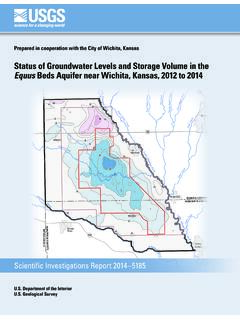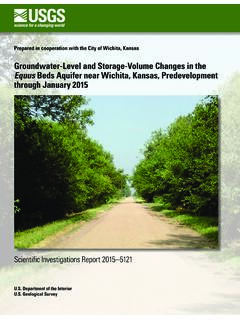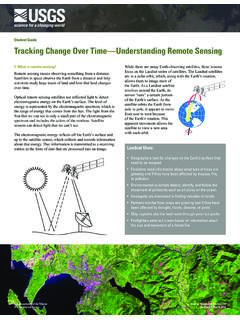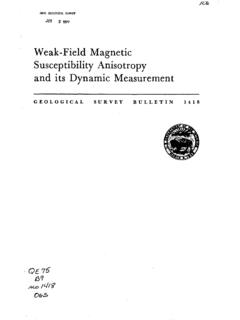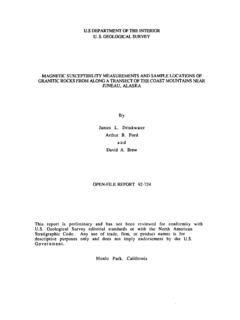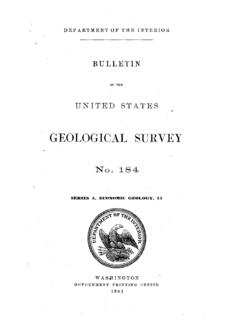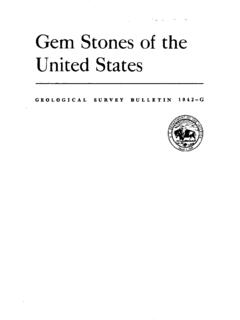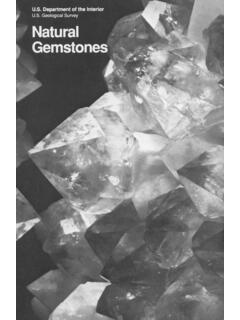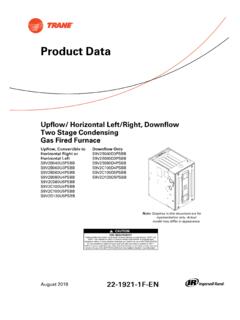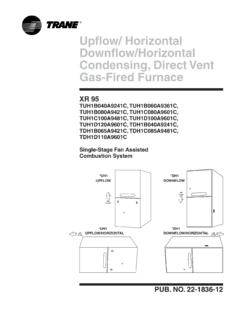Transcription of INTERIOR OF THE EARTH - USGS
1 N \ N I /\ \ /s v N N I 'GEOLOGICAL SURVEY CIRCULAR 532 /N X \ ii ' '1 / /1 / /' / 'f , / XINTERIOR OF THE EARTH / AN El/EMEI^TARYxDESCRrPNTIONThe INTERIOR of the EarthAn Elementary DescriptionBy Eugene C. RobertsonGEOLOGICAL SURVEY CIRCULAR 532 Washington 1966 United States Department of the InteriorCECIL D. ANDRUS, SecretaryGeological SurveyH. William Menard, DirectorFirst printing 1966 Second printing 1967 Third printing 1969 Fourth printing 1970 Fifth printing 1972 Sixth printing 1976 Seventh printing 1980 Free on application to Branch of Distribution, Geological Survey 1200 South Eads Street, Arlington, VA 22202 CONTENTSPageAbstract.
2 1 Introduction .. 1 Surface observations .. 1 Openings underground in various rocks .. 2 Diamond pipes and salt domes .. 3 The crust ..f .. 4 Earthquakes and the EARTH 's crust .. 4 Oceanic and continental crust .. 5 The mantle .. 7 The core .. 8 EARTH and moon .. 9 Questions and answers .. 9 Suggested reading .. 10 ILLUSTRATIONSCOVER. The INTERIOR of the 1-6. Sketches of 1. Man at the edge of a gravel pit .. 22. Gravel pit compared with Bat Cavein Carlsbad Caverns .. 23. Diamond pipe .. 34. Drill hole near salt dome .. 45. Oceanic crust at Hawaii .. 56. Continental crust under California .. 67. Generalized geologic columns.
3 68. Sketch of upper mantle and crust betweenHawaii and California .. 79. Cross section of the whole EARTH , showing thepaths of some earthquake waves .. 810. Graph of earthquake compressional wavevelocity and density in the EARTH .. 811. Diagram of EARTH and moon system .. 9iiiTHE INTERIOR OF THE EARTHBy Eugene C. RobertsonABSTRACTE vidence on the structure and composition of the EARTH 's INTERIOR comes from (1) observations of surface rocks, (2) geophysical data from earthquakes, flow of heat from the INTERIOR , the magnetic field, and gravity, (3) laboratory ex- periments on surface rocks and minerals, and (4) compari- son of the EARTH with other planets, the sun, stars, and major structural components in the EARTH that are separated by sharp discontinuities are the crust, the mantle, and the core.
4 The crust forms a very thin surface skin, the mantle is a thick shell that extends half the radius down into the EARTH , and the core occupies the central part. The crust and upper mantle are known to vary in physical and chemical characteristics, both horizontally and vertically; the lower mantle and core are generally assumed to be uniform because their diagnostic geophysical phenomena are masked by the physical-properties of the upper , the inside of the EARTH can be de- scribed as being made up of layers, in a sequence of concentric shells as illustrated on the cover. The fact that the EARTH is not a homogeneous, structure- less body has been realized since the time of Isaac Newton, who noted in a discussion of the planets that the average density of the EARTH is five to six times that of water.
5 The average density of the EARTH actually is g per em3 (grams per cubic centimeter), and as the average density of surface rocks is only about g per em3, there must be a large mass of material of higher density inside the EARTH . We infer from this and other data that there is a heavy central part in the EARTH . In fact, during the last 60 years, geophysieists and geolo- gists have estimated with increasing confidence the thickness and character of each of the successive layers in the EARTH , including variations within some has actually looked into the EARTH in deep mines and drill holes only a very small distance about 5 miles of the 4,000-mile distance to the EARTH 's center.
6 Furthermore, man will likely never be able to make a hole into the deep INTERIOR , so what we learn about the INTERIOR has to be from indirect evidence. At present, this evidence con- sists of (1) direct observation of rocks at the sur- face, (2) secondary observations based on geo- physical phenomena (including waves through the EARTH from earthquakes and explosive sources, planetary motions of the EARTH , flow of heat from the INTERIOR , the magnetic field, and gravitational attraction), (3) laboratory experiments on surface rocks and minerals, and (4) comparison of the EARTH with the other planets, the sun, stars, and meteorites, which may be fragments of a disinte- grated former planet.
7 Our present understanding of the structural features and the composition of the EARTH is obtained from all these the following discussion of the INTERIOR of the EARTH , we will use facts from these sources to con- sider layering, the existence of openings, and the physical state and composition of the rocks and minerals presumed to occur in the EARTH . Our esti- mates of composition are not much better than con- jectures at present, but they are reasonably con- sistent with geophysical OBSERVATIONSLet us start from the EARTH 's surface with fea- tures that we know and progress deeper and deeper inside the EARTH , using a series of scaled illustrations to comprehend better the sizes of structures in the EARTH .
8 First, we look at the rocks under foot at a familiar scale and then at diagram-25 Feet0 Mile FIGURE 1. Man at the edge of a gravel Feet_____0 MileFIGURE 2. Gravel pit compared with Bat Cave in Carlsbad Caverns. Contiguous caves not shown are found to 1,100 feet below the surface; the Big Room at an 830-foot depth is half a mile long and over 250 feet cross sections of the EARTH ; each structural feature is reduced in size 10 times from one drawing to the next and compared with a new fea- ture : 1 inch in the first figure will equal 10 million inches in the last. In all drawings, the vertical scale is equal to the horizontal scale, with no verti- cal the first drawing, figure 1, let us compare the length of a man's legs, about 2}/2 feet, with the depth of a gravel pit, about 25 feet; one length is 10 times the other.
9 In figure 2 the gravel pit andsteam shovel are shown reduced 10 times in size from figure 1, and a room in Carlsbad Caverns in New Mexico is sketched at this new, 10-times- smaller Underground in Various RocksThe existence of such large rooms as in the Carlsbad Caverns brings up the question of how large an opening at a given place underground can be supported by the surrounding rock. Sand and gravel like that shown in the pit in figure 1are too loose and unconsolidated to support a very large hole, and this is true of the mud or sand deposited as sediment at the bottom of a sea, lake, or river. However, mud or sand, buried beneath the EARTH 's surface by a thick deposit of similar material may be consolidated by pressure, heat, and chemical action into a sedimentary rock such as shale, sandstone, or limestone which would sup- port a large the relatively shallow depth of a thousand feet, huge natural caves, hundreds of feet in ex- tent, larger than the one illustrated in figure 2, can be dissolved out of limestone by percolating ground water, and they will stand open because most limestone is strong.
10 The weight of the rock above is not great enough to collapse the caves. On the other hand, less strong sedimentary rocks, such as shale or poorly cemented sandstone, would not support smaller openings (say, 40 ft across) under a load of a thousand feet of overlying as in limestone caves, large openings at a 1,000-foot depth can also stand in unfractured ig- neous rocks, which are composed of hard silicate minerals and which were emplaced in a molten state and then cooled to form strong, massive bod- ies. Similar openings can stand in unfractured met- amorphic rocks, which are sedimentary or igneous rocks that have been very highly compressed andheated and which are now also strong and solid.
